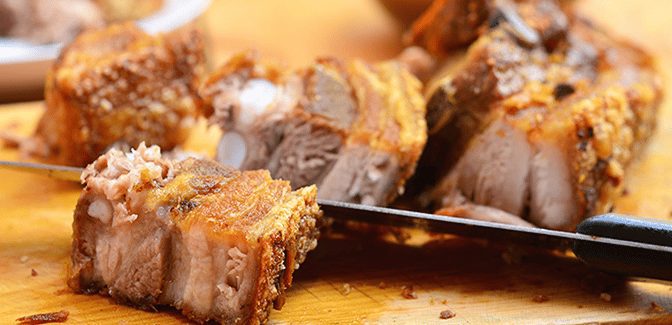Pork now often ranks as the favourite meat in urban African households – it’s official.
This was concluded in a recent qualitative study conducted on behalf of SAPPO by the company Plus94 Research in Johannesburg. The research project was generously co-sponsored by Zoetis, and the discussion groups were attended by Marieta Human and Monique Groenewald (SAPPO) and Dr Maygan Jennings, technical veterinarian and product specialist of Zoetis.
The aim was to determine urban African consumers’ meat perceptions and preferences, as well as their purchasing, cooking and consumption behaviour.
Respondents in four focus groups (who consisted of non-pork rejectors) strongly indicated that they love consuming pork frequently whenever they can afford it and ranked it as their favourite red meat.
Of special interest, says SAPPO marketing manager Marieta Human, is the fact that SAPPO’s consumer education programmes have paid off handsomely. When prompted about what had persuaded them to consume pork more often, many cited the SAPPO advertising campaigns, recipe ideas and slogans almost verbatim.
Phrases we’ve been using for years, if not decades, such as “pork is versatile, light and lean”, pork means “more meat for your money”, “putting pork on your fork is easy and delicious”, “pork is perfect for family food” and pork is “tender and tasty”, were used by many respondents, says Marieta.
“In our interactions we have found that people’s perceptions of pork has really changed. We wanted to partner with SAPPO to provide the pig producers with relevant research that could help them grow the South African pork industry, says Dr Jennings.
Respondents unanimously agreed that they are tired of eating chicken so frequently and are bored with the taste. However, it is still a staple on the family menu, as they believe buying chicken in bulk is the cheapest protein option. Chicken remains versatile and most affordable.
If pork were consistently affordable, according to their perception, especially if available as fresh, quality meat in the townships – as they claim fresh chicken is – they would eat pork far more often.
Factors influencing meat- and pork-buying decisions
• The grade of meat/pork
They claim to prefer A-grade meat or pork and would look at the stamp on the meat or label on the packaging. Some believe stamps on any meat carcass are toxic and must be cut off, or the pork should be boiled well to get rid of the stamp.
• Retailer
Respondents believe that their own trusted retailer is the source of quality. If they trust the retailer, they trust the pork being sold there. Pork or meat sold by “cheap” outlets is viewed with suspicion.
When prompted about their favourite retailers, they mentioned Shoprite, Checkers, Food Lovers Market, Woolworths and Pick n Pay, in no particular order.
• The colour of pork
Pork should have a bright pink colour and the fat must be white, not yellow. They said if the pork meat is white in certain parts of a cut, it means the pork is very old. Also, heavily marinated pork or chicken cuts are avoided because they believe the retailer is trying to hide the colour of the meat.
• Restaurants
They believe the flavour of pork dishes is better in restaurants, especially pork ribs and rib burgers. Spur remains a firm favourite for eating pork ribs.
Respondents also claim to enjoy pork chops and eisbein in restaurants. They try to interpret the flavours of pork dishes they encounter in restaurants to use as inspiration for their home cooking.
• Township street food
Pork is sometimes consumed in the form of trotters, ribs, bunny chows containing ham or Russians, or “kotas”, and they enjoy these street-food offerings.
• Freshness
Respondents said they simply look at the expiry date on the packaging to judge the freshness.
They are suspicious of frozen meat/pork as they don’t know how long it had been frozen. A fair amount of trust is placed in retailers to ensure that the meat on offer is fresh.
• Different cuts at different prices
These urban respondents are relatively, but not highly, aware of the fact that different cuts are sold at different prices. They regard pork bones as the cheapest meat, followed by chicken. Beef, lamb/mutton, game and fresh fish are regarded as very expensive.
Pork is generally regarded as “affordable, delicious and versatile”, as it can be enjoyed in a variety of ways for breakfast, lunch and dinner.
Negatives inhibiting pork consumption
The old tonsillitis and allergy beliefs still linger, but are becoming less of a factor among younger people. Some respondents claim that Worcestershire sauce, lemon juice or vinegar will cure tonsillitis caused by pork, or that the process of boiling pork twice and throwing the water away will prevent it from causing tonsillitis and allergies and get rid of the “off” taste. Some also believe you can “outgrow” a pork allergy.
Religious reasons
• Pig are dirty – although some claim that pork can be “cleaned” by boiling it well or boiling it twice.
• Unhealthy – some think the high fat content can cause heart diseases. A few respondents also believe pigs don’t sweat, meaning that the toxins are not eliminated from their bodies and will be harmful to humans.
• Pork is slimy – when consumers boil pork, the skin turns slimy, which is a big turn-off.
• Intestines are not safe – only some respondents believe this.
Perceptions about pork production on farms
There is very low awareness of how pigs are reared. They feel this is not a priority for them at all.
Respondents indicated that they consciously or sub-consciously believe prominent retailers make it their job to sell pork meat which is produced in a good environment and is safe and of good quality.
The terms organic and free-range provoked very low or no understanding, just confusion. Some respondents felt that these terms are merely a marketing ploy.
Very few respondents had any awareness, knowledge or understanding regarding vaccinations, antibiotics or other treatments administered to pigs that end up being consumed by them.
They hinted again that they basically trust “the system” or the retailer, to make sure the pork they eat is good to consume.
Positives and learnings for SAPPO
The availability of fresh, good quality, affordable cuts in township areas still leave a lot to be desired. Clever suppliers should take note of these opportunities.
Targeted campaigns over a long enough period undoubtedly works, says SAPPO’s Marieta, as a huge shift in perception, achieved over the last ten years, is obvious.
These respondents rated the taste of pork as superior to the taste of chicken, and they felt that it is quite easy to prepare pork to get a tasty meal with rich flavour.
They expressed a never-ending demand for very simple, easy recipes, using few ingredients to help them learning to cook pork, and to enhance their pork cooking skills. Younger consumers are much more open and enthusiastic to consume pork frequently.
The barriers to consumption in the current era are different, and perhaps not quite as tough, as the perceptual challenges SAPPO managed to overcome during the last 10 – 15 years.
Continued educational campaigns are vital, to maintain a share of mind and convert awareness into pork purchases, says Marieta.
The South African Pork Producers’ Organisation (SAPPO) coordinates industry interventions and collaboratively manages risks in the value chain to enable the sustainability and profitability of pork producers in South Africa.








